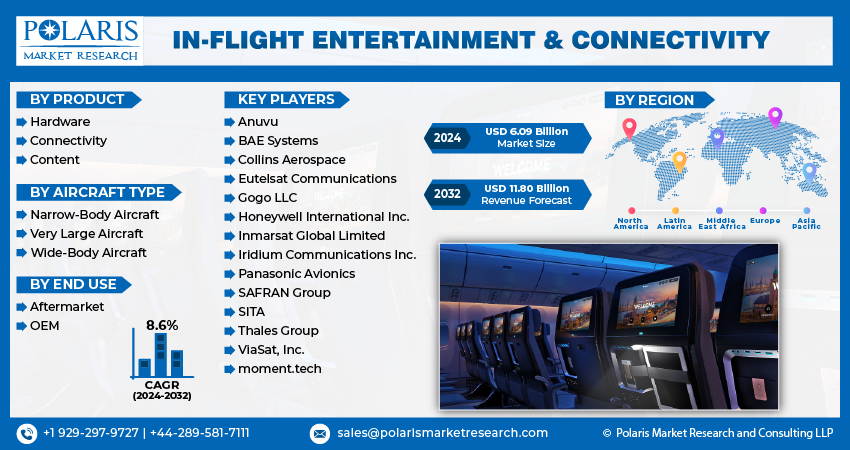The global In-flight entertainment and connectivity (IFEC) market was valued at USD 5.63 billion in 2023 and is projected to grow at a compound annual growth rate (CAGR) of 8.6% during the forecast period. This growth is driven by increasing passenger expectations for enhanced travel experiences, advancements in connectivity technology, and the proliferation of digital content consumption.
IFEC systems provide passengers with entertainment options such as movies, TV shows, games, and music while offering connectivity solutions for browsing, communication, and business purposes. Airlines are increasingly investing in IFEC to enhance customer satisfaction and differentiate their offerings in a competitive market.
Key Market Drivers
- Growing Passenger Expectations for Enhanced Experiences
Modern passengers demand more personalized and engaging in-flight experiences. Airlines are meeting this demand by incorporating advanced entertainment systems and high-speed internet connectivity to ensure passengers stay connected and entertained during their journeys. - Advancements in Connectivity Technology
The development of satellite-based and air-to-ground communication technologies has significantly improved in-flight internet speeds and reliability. This has enabled airlines to provide seamless connectivity, facilitating activities such as streaming, online shopping, and real-time communication. - Rising Aircraft Deliveries
The increasing global air travel demand has led to a rise in aircraft deliveries, particularly in emerging economies. Many of these new aircraft come equipped with state-of-the-art IFEC systems, contributing to market growth. - Demand for Wireless Streaming Services
The shift toward wireless content streaming in the aviation industry has reduced the reliance on seatback screens, allowing airlines to offer a broader range of content via passengers’ personal devices. This trend enhances user convenience and reduces equipment weight, improving fuel efficiency. - Airline Differentiation Strategies
In a highly competitive aviation market, airlines are leveraging IFEC systems as a key differentiator to attract and retain customers. Enhanced entertainment options and reliable connectivity help airlines build brand loyalty and improve their overall service value.
Market Challenges
- High Installation and Maintenance Costs
The installation of advanced IFEC systems involves significant capital investment, particularly for retrofitting older aircraft. Ongoing maintenance and updates also contribute to operational expenses, which can be a barrier for smaller airlines. - Regulatory and Security Concerns
The use of IFEC systems must comply with stringent aviation safety and cybersecurity regulations. Ensuring data security and preventing cyberattacks pose challenges for service providers and airlines. - Limited Connectivity in Remote Areas
Despite advancements in satellite technology, providing reliable connectivity in remote regions such as oceans and polar areas remains a challenge. This limitation can impact the passenger experience on long-haul flights.
Key Industry Players
Leading players in the IFEC market are investing in R&D, partnerships, and technological innovations to strengthen their market position. Key companies include:
- Anuvu
- BAE Systems
- Collins Aerospace
- Eutelsat Communications
- Gogo LLC
- Honeywell International Inc.
- Inmarsat Global Limited
- Iridium Communications Inc.
- Panasonic Avionics
- SAFRAN Group
- SITA
- Thales Group
- ViaSat, Inc.
- moment.tech
Recent Developments
- Satellite-Based Connectivity Solutions
Companies such as Viasat and Thales are deploying next-generation satellites to enhance global connectivity coverage and provide faster internet speeds. These advancements support high-bandwidth activities like video conferencing and streaming. - Integration of Artificial Intelligence (AI)
AI is being integrated into IFEC systems to provide personalized content recommendations, voice-assisted controls, and enhanced passenger interaction. These innovations improve user satisfaction and system efficiency. - Expansion of Content Offerings
Airlines are partnering with leading content providers to offer a wide range of entertainment options, including regional movies, live TV, eBooks, and gaming. This strategy caters to diverse passenger preferences and enhances the travel experience.
𝐄𝐱𝐩𝐥𝐨𝐫𝐞 𝐓𝐡𝐞 𝐂𝐨𝐦𝐩𝐥𝐞𝐭𝐞 𝐂𝐨𝐦𝐩𝐫𝐞𝐡𝐞𝐧𝐬𝐢𝐯𝐞 𝐑𝐞𝐩𝐨𝐫𝐭 𝐇𝐞𝐫𝐞:
Market Segmentation
The IFEC market is segmented based on components, connectivity type, aircraft type, and region.
- By Components
- Hardware (Displays, Servers, Modems, Antennas)
- Software (Entertainment Content, Flight Management Systems)
- Services (Installation, Maintenance, Managed Connectivity)
- By Connectivity Type
- Satellite Connectivity
- Air-to-Ground Connectivity
- By Aircraft Type
- Narrow-Body Aircraft
- Wide-Body Aircraft
- Business Jets
- By Region
- North America
- Europe
- Asia-Pacific
- Latin America
- Middle East & Africa
The In-flight entertainment and connectivity market is poised for significant growth as airlines increasingly focus on providing differentiated, passenger-centric experiences. The adoption of cutting-edge technologies such as 5G connectivity, AI, and cloud-based systems will drive market expansion, while collaborations between airlines and technology providers will accelerate innovation.
𝐁𝐫𝐨𝐰𝐬𝐞 𝐌𝐨𝐫𝐞 𝐑𝐞𝐬𝐞𝐚𝐫𝐜𝐡 𝐑𝐞𝐩𝐨𝐫𝐭𝐬:

